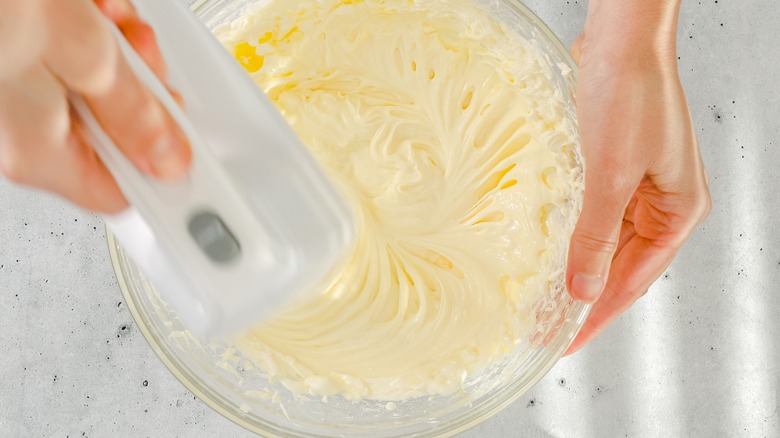Why You Should Never Mix Cheesecake Batter On High Speed
Baking is a delicate chemistry with seemingly arbitrary rules that are hard to keep track of. When it comes to making most types of cakes, several questions come to mind: Will the fat of choice be butter, oil, or both? Is the crumb airy or dense? How many eggs are added? These are only a few factors that contribute to a cake's texture, appearance, and flavor, outside of obvious components like fruit or chocolate.
However, when it comes to cheesecake, it's an entirely different beast than that of regular cake. First and foremost, cheesecake isn't technically cake since it isn't flour-based and comprises cheese, eggs, and sugar. It is smooth and creamy and has a more defined crust on the outside, similar to that of a pie. But just like a regular cake, the result of a perfectly made cheesecake also depends on the mixing method.
If you're making a classic cheesecake, you must consider its texture and density. It has that smooth, rich mouthfeel while simultaneously being lighter than the more dense New York kind, per Greatist. To accomplish the specific density of either type of cheesecake, it's essential to pay attention to the ratio of your ingredients and how you incorporate them together.
Overmixing may lead to cracks and a grainy texture
Overmixing your batter can ruin the structure and texture of your cheesecake. With a batter mainly composed of cream cheese, sugar, and egg yolks, you can quickly form cracks in your cheesecake with the excess air that comes from overmixing (via Cheesecakes World). Furthermore, using the high-speed option on your mixer can cause the cream itself to split and curdle, creating that unpleasant grainy mouthfeel when you take your first bite.
In truth, the marker of a good cheesecake relies on smooth texture, the right amount of firmness, and that it moves with a slight jiggle once removed from the oven, according to Better Homes & Gardens. And beating your cream cheese and eggs vigorously can ruin these crucial components of a cheesecake.
For example, Just One Cookbook notes that a recipe for a Japanese soufflé cheesecake may call for high-speed mixing for stiff peaks, but even over-whipping could lead to a cracked result. The best way to avoid high-speed mixing is to use room-temperature ingredients that will meld together easily. If your cream cheese is at room temperature, even hand-mixing your ingredients will give you a creamy, homogenous batter.
So, whichever cheesecake you decide to make, be patient with the mixing process — low and slow is always the way to go.

